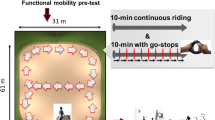Abstract
Objectives
The purpose of this preliminary investigation was to determine if a program using pedal-less bicycles could improve stability scores among children with ASD.
Methods
A sample of eight children with ASD (average age, 7 ± 1.15) were recruited. The investigators tested each participant on a posturography plate for five consecutive weeks. The group used pedal-less bicycles, three times per week for five consecutive weeks. A MANOVA determined if center of pressure (CoP) or limit of stability (LoS) scores improved within the group.
Results
LoS anterior, LoS posterior, right sagittal, and left sagittal indicated statistically significant improvements over time; the greatest improvement was seen in left sagittal assessments which improved from an average of 1.75 during baseline to an average of 3.03 at week 5.
Conclusions
There was evidence of a significant association between pedal-less bicycles and mean LoS scores among children with ASD. This investigation determined the use of pedal-less bicycles can improve stability scores among children with ASD within a 5-week session, if performed at least three times per week.



Similar content being viewed by others
References
American Psychiatric Association. (2013). Diagnostic and statistical manual of mental disorders 5e. Washington, DC: Author.
Cheldavi, H., Shakerian, S., Boshehri, S. N. S., & Zarghami, M. (2014). The effects of balance training intervention on postural control of children with autism spectrum disorder: role of sensory information. Research in Autism Spectrum Disorders, 8, 8–14.
Fournier, K. A., Kimberg, C. I., Radonovich, K. J., Tillman, M. D., Chow, J. W., Lewis, M. H., et al. (2010). Decreased static and dynamic postural control in children with autism spectrum disorders. Gait & Posture, 32, 6–9.
Henry, F.M. (1968). Specificity vs. generality in learning motor skill. In R.C., & G.S. Kenyon (Eds.), Classical studies on physical activity. Englewood Cliffs, NJ: Prentice-Hall.
Henry, F. M., & Roqers, D. E. (1960). Increased response latency for complicated movements and a memory drum theory of neuromotor reaction. Research Quarterly, 31, 448–458.
Klue, M., Miyahara, M., & Heveldt, K. (2011). A case study to evaluate balance training with movement test items and through teaching observations: beyond specificity and transfer of learning. Physical Education and Sport Pedagogy, 17(5), 463–475.
Leineweber, M. J., Wyss, D., Dufour, S. K., Gane, C., Zabjek, K., Bouyer, L. J., & Andrysek, J. (2016). The effects of acute intense physical exercise on postural stability in children with cerebral palsy. Adapted Physical Activity Quarterly, 33(3), 271–282.
Lim, B., O’Sullivan, D., Choi, B., & Kim, M. (2016). Comparative gait analysis between children with autism and age matched controls: analysis with temporal-spatial and foot pressure variables. Journal of Physical Therapy Science, 28, 286–292.
MacDonald, M., Espositio, P., Hauck, J., Jeong, I., Hornyak, J., Argento, A., & Ulrich, D. (2012). Bicycle training for youth with down syndrome and autism spectrum disorders. Focus on Autism and Other Developmental Disabilities, 27(1), 12–21. https://doi.org/10.1177/1088357611428333.
Memari, A. H., Ghanouni, P., Gharibzedeh, S., Eghildi, J., Ziaee, A., & Moshayedi, V. P. (2013). Postural sway patterns in children with autism spectrum disorder compared with typically developing children. Research in Autism Spectrum Disorders, 7, 325–332.
Miyahara, M., Tsujii, M., Hanai, T., Jongmans, M., Henderson, S., Barnett, A., Hori, M., Nakanishi, K., & Kageyama, H. (1998). The movement assessment battery for children: a preliminary investigation of its usefulness in Japan. Human Movement Science, 17, 679–697.
Molloy, C. A., Dietrich, K. N., & Bhattacharya, A. (2003). Postural stability in children with autism spectrum disorder. Journal of Autism and Developmental Disorders, 33(6), 643–652.
Mostofky, S. H., Poweel, S. K., Simmonds, D. J., Goldberg, M. C., Caffo, B., & Pekar, J. J. (2009). Decreased connectivity and cerebellar activity in autism during motor task performance. Brain, 132, 2413–2425.
Park, S. H., Song, Y. J., Demetriou, E., Pepper, K. L., Norton, A., Thomas, E. E., Hickie, I., Hermens, D., Glozier, N., & Guastella, A. J. (2019). Disability, functioning, and quality of life among treatment-seeking young autistic adults and its relation to depression, anxiety and stress. Autism. https://doi.org/10.1177/13623618823925.
Reinert, S., Jackson, K., & Bigelow, K. (2015). Using posturography to examine the immediate effects of vestibular therapy for children with autism spectrum disorders: a feasibility study. Physical & Occupational Therapy in Pediatrics, 35(4), 365–380. https://doi.org/10.3109/01942638.2014.975313.
Shim, A. L., & Norman, S. (2015). Incorporating pedal-less bicycles into a pre-K through third grade curriculum to improve stability in children. Journal of Physical Education, Recreation & Dance, 86(1), 50–51. https://doi.org/10.1080/07303084.2015.978681.
Ulrich, D. A., Burghardt, A. R., Lloyd, M., Tiernan, C., & Hornyak, J. E. (2011). Physical activity benefits of learning to ride a two-wheel bicycle for children with down syndrome: a randomized trial. Physical Therapy, 91(10), 1463.
Acknowledgments
The author would like to extend sincere gratitude to Dr. Sean Peterson and Ms. Jan Turbes with their assistance with collecting ADOS scores from the children. Supplementary materials such as ramps, safety helmets, and pedal-less bicycles were provided by can Strider Bikes LLC at http://www.striderbikes.com.
Author information
Authors and Affiliations
Contributions
AS was responsible for developing the study, collecting and analyzing the data, and writing the manuscript. DN and JH collaborated in analyzing the data and writing/editing the manuscript. KV assisted in writing and editing the manuscript.
Corresponding author
Ethics declarations
Conflict of Interest
The authors declare that they have no conflicts of interest.
Ethical Approval
The study was approved by the Institutional Review Board at Briar Cliff University in Sioux City IA. All procedures performed were in accordance with the ethical standards of the institutional and/or national research committee and with the 1964 Helsinki declaration and its later amendments or comparable ethical standards.
Additional information
Publisher’s Note
Springer Nature remains neutral with regard to jurisdictional claims in published maps and institutional affiliations.
Rights and permissions
About this article
Cite this article
Shim, A., Newman, D., Haegele, J. et al. The Effects of a Pedal-Less Bicycle Intervention on Stability Scores Among Children with Autism Spectrum Disorder. Adv Neurodev Disord 4, 20–26 (2020). https://doi.org/10.1007/s41252-019-00131-z
Published:
Issue Date:
DOI: https://doi.org/10.1007/s41252-019-00131-z




